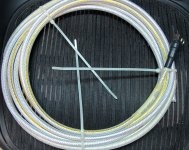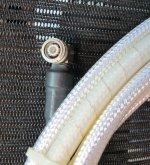Thanks for your and Markw4's feedback. Noise and harmonics are generated by the diodes in the power supply switching on and off. We know this, I measured it and wrote about it over 25yrs ago. Now where is this noise going to go? It is going to want to take the path out out of the equipment thru the power cord to the point of lowest impedance, the power company. Where else is it going to go?I'm with Markw4, and would refrain from making such a claim unless I could provide the physical mechanism behind it.
All I know is that harmonic frequencies in the power system can be damped by providing them with a low impedance path to ground.
Exactly! the noise, leakage and ground currents will take all available paths back to the power company transformer down the street.Thanks for your and Markw4's feedback. Noise and harmonics are generated by the diodes in the power supply switching on and off. We know this, I measured it and wrote about it over 25yrs ago. Now where is this noise going to go? It is going to want to take the path out out of the equipment thru the power cord to the point of lowest impedance, the power company. Where else is it going to go?
Most current will flow thru the low impedance Neutral & Safety Ground/Protective Earth conductors. But a little may flow thru your interconnect cables and thru Planet Earth.
This quote is from the Shunyata web site.
"A primary source of audible sonic degradation is caused by the power supplies. Most components use FWBR (full wave bridge rectifier) power supplies that generate an incredible amount of transient noise when the rectifiers switch on and off. The design of a power cord can significantly affect the reactance of these signals within the power supply. Because the power cord is part of the primary winding of the power transformer, the transition between the various metals used in a PC can cause EM reflections and diode-like rectification of the noise impulses as they propagate away from the power supply. If the PC presents a high impedance to these signals they will be reflected back into the power supply where they will intermodulate increasing the high frequency noise levels of the component. Most power supply filters are ineffective at blocking very high frequency noise components and much of it is passed through to the DC rails. The sonic effects of this include: high background noise levels, blurred or slurred transients and a general lack of clarity and purity of the sound or visual image."
Shunyata wants to get the noise inside the equipment out and away from the equipment through the power cord.
"A primary source of audible sonic degradation is caused by the power supplies. Most components use FWBR (full wave bridge rectifier) power supplies that generate an incredible amount of transient noise when the rectifiers switch on and off. The design of a power cord can significantly affect the reactance of these signals within the power supply. Because the power cord is part of the primary winding of the power transformer, the transition between the various metals used in a PC can cause EM reflections and diode-like rectification of the noise impulses as they propagate away from the power supply. If the PC presents a high impedance to these signals they will be reflected back into the power supply where they will intermodulate increasing the high frequency noise levels of the component. Most power supply filters are ineffective at blocking very high frequency noise components and much of it is passed through to the DC rails. The sonic effects of this include: high background noise levels, blurred or slurred transients and a general lack of clarity and purity of the sound or visual image."
Shunyata wants to get the noise inside the equipment out and away from the equipment through the power cord.
Thank you Speedskater! I agree with you.Exactly! the noise, leakage and ground currents will take all available paths back to the power company transformer down the street.
Most current will flow thru the low impedance Neutral & Safety Ground/Protective Earth conductors. But a little may flow thru your interconnect cables and thru Planet Earth.
they generate a transient resulting from the leakage inductance of the transformer and the junction capacitance of the diodes. The problem is easily remedied by selecting an RC snubber in which the transient energy is converted to heat. Most times in our world of linear audio, the snubber is a solution searching for a problem.This quote is from the Shunyata web site.
"A primary source of audible sonic degradation is caused by the power supplies. Most components use FWBR (full wave bridge rectifier) power supplies that generate an incredible amount of transient noise when the rectifiers switch on and off.
It is a problem in switching supplies in which di/dt is large. Basso has written several application notes for ON-Semi on the topic.
What makes you think the power company has low impedance at high frequencies? There are a series of power transformers that may be or may not be low impedance at high frequencies. And low impedance in what sense, differentially between line and neutral, line to ground, or neutral to ground?Noise and harmonics are generated by the diodes in the power supply switching on and off. We know this, I measured it and wrote about it over 25yrs ago. Now where is this noise going to go? It is going to want to take the path out out of the equipment thru the power cord to the point of lowest impedance, the power company. Where else is it going to go?
Also, sounds you are talking about what we call diode commutation ringing of audio device power transformer leakage reactances. There is also distortion IR distortion of line voltage caused by peak rectified current flow. Those are two different things. That doesn't even start to get into what happens with SMPS, vaccum cleaner motors, etc.
The 'energy' involved doesn't necessarily have to go anywhere, no more than the voltage in a battery has to go anywhere. It can remain as potential energy. A lot of times voltage noise on the power line is not simply dissipated into a low impedance. If it was we wouldn't see so much voltage noise on the line, it would be more or less shorted out. But being shorted out doesn't mean its energy has turned to heat yet, it could turn into current noise and cause another set of problems.
The whole subject can be enormously complex. Its clear that the model you have in your head about what happens is quite over simplified, pretty much to the point of being more misleading than illuminating.
And more nonsense with a few engineering facts thrown in to cloud the issues.This quote is from the Shunyata web site.
engineering facts thrown in to cloud the issues.
equals Bob Pease's "floobydust"engineering facts thrown in to cloud the issues.
Speaking of floobydust, let's see what it means:
https://www.electronicdesign.com/archive/article/21799032/whats-all-this-floobydust-stuff-anyhow
It says:
"First of all, I should explain that "Floobydust" is an old term that was invented here at National, a phrase coined by Dennis Bohn, meaning "miscellaneous" or "potpourri" - a "Mixed bag." A catch-all phrase. And that's what we have this month."
Okay then, still not quite clear how "engineering facts thrown in to cloud the issues..." type language exactly fits into Pease's definition?
Is it just about a mixed bag of truth and fiction?
https://www.electronicdesign.com/archive/article/21799032/whats-all-this-floobydust-stuff-anyhow
It says:
"First of all, I should explain that "Floobydust" is an old term that was invented here at National, a phrase coined by Dennis Bohn, meaning "miscellaneous" or "potpourri" - a "Mixed bag." A catch-all phrase. And that's what we have this month."
Okay then, still not quite clear how "engineering facts thrown in to cloud the issues..." type language exactly fits into Pease's definition?
Is it just about a mixed bag of truth and fiction?
Here's the cable for you -- PICWire S22089 -- just what you need for your TCAS. I got this when they re-did the avionics in a Hawker 800:
https://www.picwire.com/pic-cables/s22089/
https://www.picwire.com/pic-cables/s22089/
Attachments
Bunch of nonsense.This quote is from the Shunyata web site.
"A primary source of audible sonic degradation is caused by the power supplies. Most components use FWBR (full wave bridge rectifier) power supplies that generate an incredible amount of transient noise when the rectifiers switch on and off. The design of a power cord can significantly affect the reactance of these signals within the power supply. Because the power cord is part of the primary winding of the power transformer, the transition between the various metals used in a PC can cause EM reflections and diode-like rectification of the noise impulses as they propagate away from the power supply. If the PC presents a high impedance to these signals they will be reflected back into the power supply where they will intermodulate increasing the high frequency noise levels of the component. Most power supply filters are ineffective at blocking very high frequency noise components and much of it is passed through to the DC rails. The sonic effects of this include: high background noise levels, blurred or slurred transients and a general lack of clarity and purity of the sound or visual image."
Shunyata wants to get the noise inside the equipment out and away from the equipment through the power cord.
It's quite simple, all you have to do is make sure your power cable is optimised for the best sound quality by its length!
Like this power cable (I've decided not to name the cable or the company that makes it, but this is a quote from their literature):
Like this power cable (I've decided not to name the cable or the company that makes it, but this is a quote from their literature):
Listening tests showed consistently that the best sound quality was obtained from cables cut to a length of 1.65m (wire length 1.68m after untwisting).
This aligns very closely with the quarter wavelength of the 50 Hz mains frequency of 1.7m.
the quarter wavelength of the 50 Hz mains frequency of 1.7m.
It's actually several miles.
It's actually several miles.
Oh PLEASE!!!!
That guy has NO CLUE or even worse, is writing in bad faith.
We are talking a cable here, not a resonant pipe, so electrical wavelength is about 1000 miles/1500km.
That guy has NO CLUE or even worse, is writing in bad faith.
We are talking a cable here, not a resonant pipe, so electrical wavelength is about 1000 miles/1500km.
JMF, I've ignored this particular thread for obvious reasons, it being just another one of those "wire" threads.Oh PLEASE!!!!
That guy has NO CLUE or even worse, is writing in bad faith.
We are talking a cable here, not a resonant pipe, so electrical wavelength is about 1000 miles/1500km.
But I have to say your comments always get a smile from me.
When questioned, the manufacturer said he meant the quarter wavelength of a sound wave of frequency 50 Hz travelling at 340 m/s - which is 1.7 m.
He then invoked some sort of acoustical resonance phenomenon to explain the effectiveness of the power cable.
He then invoked some sort of acoustical resonance phenomenon to explain the effectiveness of the power cable.
It rests on HIS shoulders to prove a 1.70 meter length of copper cable has any resonance approaching 50 Hz.
Either electrical or acoustic.
Either electrical or acoustic.
I don't listen to the babble of those nutcases that profess to be authorites and experts.It rests on HIS shoulders to prove a 1.70 meter length of copper cable has any resonance approaching 50 Hz.
Either electrical or acoustic.
The internet is loaded with goofballs like that.
- Status
- Not open for further replies.
- Home
- Member Areas
- The Lounge
- Power Conditioners and Cords

